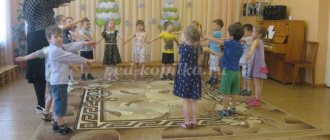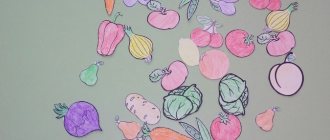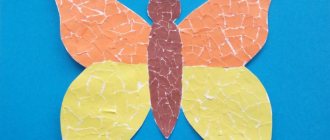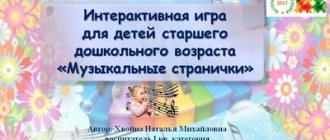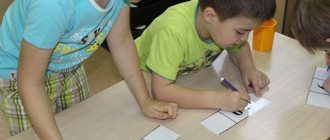Summary of GCD in the first junior group. Sun
Summary of educational activities in the first junior group “Sun - Bell”
Educational areas: cognitive development, speech development, artistic and aesthetic development. Goal: development of children's cognitive abilities. Objectives: Educational:
• Continue to introduce children to Russian folk nursery rhymes;
to develop children’s ability to select objects by shape, color, to teach them to distinguish between round geometric shapes and the color yellow. • Learn to convey the image of the sun, improving children’s skills. Teach the technique of flattening to obtain a flat image of the original shape. Developmental:
• Develop a sense of form, rhythm, fine motor skills.
Educators:
• To cultivate in children responsiveness, kindness, the ability to sympathize with the characters, and the desire to help them.
Cultivate positive emotions in joint creative activities. Preliminary work: examining images of the sun in children's books and objects of decorative and applied art. Watching the sun while walking. Reading poems, nursery rhymes. Material for the lesson: a model depicting a house with closed shutters that can open and show the sun in the window;
thick cardboard (blue, dark blue) square in shape with silhouettes of animals; red and yellow plasticine; beads, buttons; modeling board; hand napkin GCD move
1.
Organizational part. (Children enter the group and see the house of the sun with closed shutters)
.
- Guys, look what a beautiful house. Who do you think lives in it? - This is the house of the sun. But it is sleeping. Oh, let's wake him up. Children: The sun is a bell, Look out the window! Sunny, dress up, Red, show yourself! (The shutters open, an image of the sun is visible in the window. The shutters close again. The game is played 2-3 times)
.
— The sun woke up and smiled at everyone. - How brightly the sun shines! It strokes your cheeks, forehead, nose, heads, and looks to see if everything is okay (perform the appropriate movements)
.
He looks through the window and sees you playing in kindergarten. The sun looks out the window, (the children shake their heads left and right)
It shines into our room.
(show flashlights)
We clapped our hands, We were very happy about the sun.
(clap their hands)
- Look at the sun?
(Round.) Children, following the teacher, draw the sun in the air with their fingers.
2.
Main part . - The sun has a lot to do: warm the earth, illuminate it with bright light, wake everyone up with its gentle rays - flowers, birds, bunnies and squirrels, boys and girls. The finger game “Sun” is being played. The sun rose early in the morning and caressed all the children. (Cross your palms. Spread your fingers wide, forming a “sun with rays.”)
- What beautiful rays you have created!
— The sun came into our group and wanted to play with you, what about you? Game “Find objects the same color as the sun” - Guys, what color is the sun? (Yellow) - Shall we give the sun yellow objects? (Children find yellow objects)
.
Game “Find an object shaped like the sun” - What shape is the sun? (Round) - Shall we give the sun round objects? (On the table there are pictures: watermelon, orange, ball, wheel, wardrobe, melon, spruce, hat, ball, bun, TV)
Children choose pictures.
- Well done! - Why didn’t you take the bun? Ball? Melon? (They are not round) - Well done! The sun says to you: “Thank you!” He enjoyed playing with you so much. Physical school is being held , Sunshine, sunshine, Look out the window, The kids are waiting for you, The kids are waiting for you. (“Springs” on two legs)
Bucket sun!
Look out the window! Your children are crying, jumping on the pebbles. (Jumping on two legs)
Sunshine, show yourself!
Red, appear! (Children turn to the window and stretch their arms forward.)
- Children, little animals came to us who also want to bask in the sun, but a cloud hid the sun from them.
(give the children cardboard with little animals depicted in the corner
) - And you want to help our friends.
To make the sun look like a real one, let's remember what it is like? What does the sun look like? (for a ball, a circle, a ball...) - What color can it be? (red, yellow) - That’s right, our sun is warm, so we will sculpt it from yellow plasticine. Stages of work execution. - Take one piece of plasticine. Place it between your palms and roll the ball in a circular motion, pressing it with your palm. — Place the finished ball in the middle of the cardboard and lightly press on it, flatten it so that the sun ball is fixed on the cardboard. — From the second piece, roll a sausage between your palms, using straight hand movements (one hand moves forward, the other back).
Attach the resulting ray-column to the sun, point it at the animal, and lightly press it against the picture
(places the flagella around the disk)
.
- Where are the sun’s eyes? Here they are! (I take the beads and attach them)
.
I will draw a mouth with a toothpick. The sun looks at us and smiles! The teacher invites the children to create their own suns
.
3. Final part The cloud hides behind the forest, The sun looks from the sky. And so pure, kind, radiant! If we could get him, We would kiss him. - Guys, the sun thanks you for helping him out. What a beautiful picture we got. The sun invites you to play with your sons - rays of sunshine. Outdoor game “Sunny bunnies” The teacher uses a small mirror to release a sunny bunnie and read a poem: Sunny bunnies are playing on the wall, I’ll beckon them with my finger, let them run to me. Well, catch it, catch it quickly! Here it is, a bright circle, Here, here, here - to the left, to the left! He ran to the ceiling. Jump! Children catch a bunny on the wall. The teacher points the mirror lower, higher: the children jump up and try to catch the bunny.
We recommend watching:
Summary of educational activities in the first junior group using ICT on the topic “Grains for chicken” Summary of educational activities in the first junior group on the formation of a holistic picture of the world Summary of a lesson by a teacher-psychologist with young children Thematic day in the first junior group. Abstract
Similar articles:
Summary of a lesson for children 2-3 years old on the topic “My beloved dad!”
Benefits for preschool children under the general title “Sad - Fun”
Didactic manual
for preschool children
"Sad - fun"
Explanatory note
The manuals under the general title “Sad and Happy” were created for children aged 5-7 years. They can be used in frontal classes, in working with a subgroup of children on musical development, solving problems in the “Didactic game” and “Listening to music” sections.
Target
: learn to model the character of music, develop modal perception of music
More expected results
: children will distinguish musical works, name some composers, and will be able to model the nature of musical works.
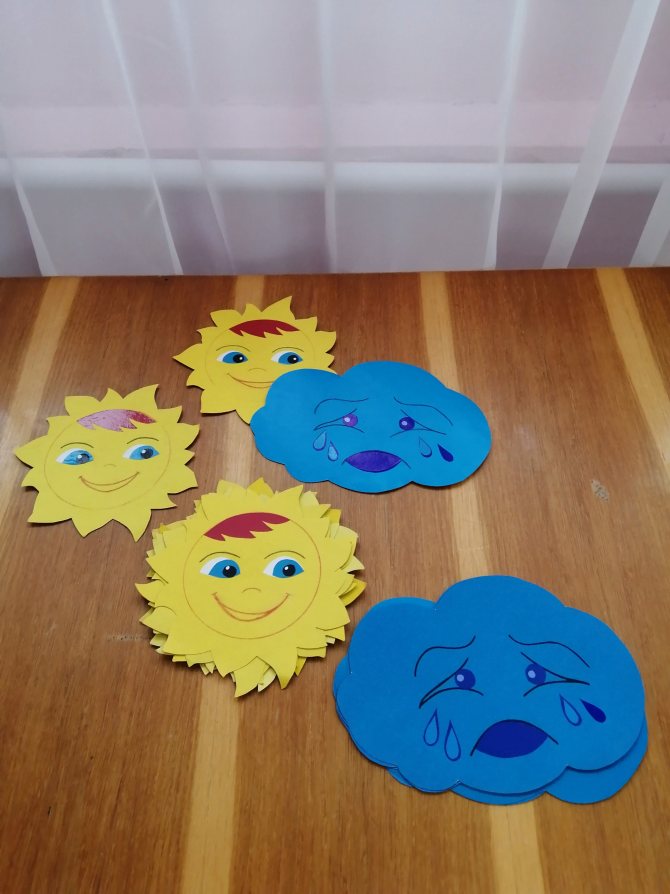
“Sun and cloud” (for magnetic board)
The manual was developed for children 5 years old (middle group). The manual consists of figured pictures (22X15) of the sun and clouds, symbolically denoting cheerful and sad music; magnets are glued to the back of the pictures. After listening to a piece of music, the child (of his own free will) comes to the table, selects a picture that matches the character of the music and attaches it to the magnetic board.
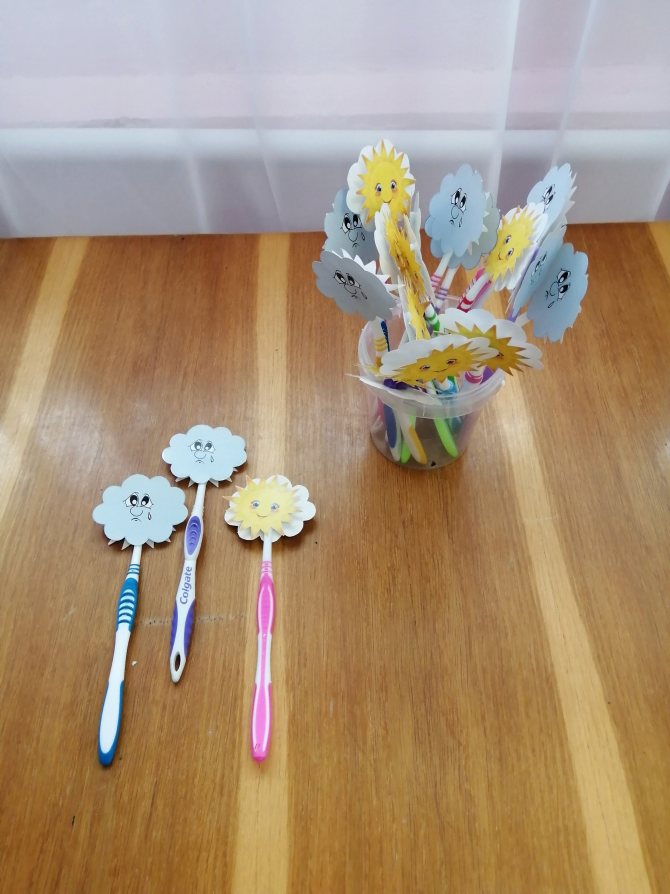
“The Sun and the Cloud” (on a stick)
The manual was developed for children 5-6 years old (middle, senior group). The manual consists of small figured pictures (6/7X6) of the sun and clouds, which are glued to two sides of a flat stick (toothbrush handle). The number of sticks should correspond to the number of children. After listening to a piece of music, children turn the image of the sun towards themselves if the music was cheerful, or a cloud if the music was sad.
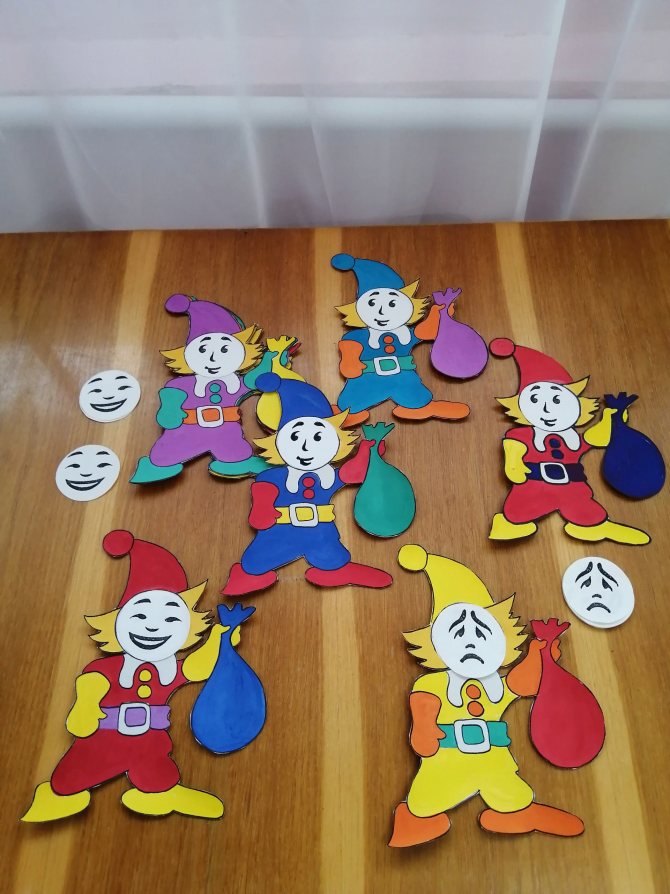
"Determine the mood of the gnomes"
The manual was developed for children 6-7 years old (senior, preparatory group). The manual consists of figured pictures of gnomes with a calm expression on their faces, circles with sad and cheerful facial expressions. The number of pictures of gnomes can correspond to the number of children, and can be designed for a subgroup of 8-10 children. In accordance with the nature of the music, children put circles on the gnome's face, that is, they change his mood in accordance with the nature of the music. The game is not played at the table, so each child receives a cardboard tablet on which he places a gnome figurine.

“Sad and happy” (color cards)
The manual was developed for children 6-7 years old (senior, preparatory group). The manual consists of cards with colored circles: red, symbolically denoting happy music, and blue, symbolically denoting sad music. Children are given two cards. In accordance with the nature of the music, children show cards with a red or blue circle.

“Sad and happy” (cards with facial expressions)
The manual was developed for children 7 years old (preparatory group). The manual consists of cards with happy, sad and calm facial expressions. Children are given two cards. At the first stage of mastering the game, children are given cards only with sad and cheerful facial expressions, then with cheerful and calm ones. After 2-3 lessons, different cards are distributed, some children have happy and sad facial expressions, others have cheerful and calm facial expressions, others have sad and calm facial expressions. In accordance with the music they listened to, the children raise a card and show it to the music director. If the child does not have the appropriate card, then he does not show the card. For example, a music director plays a piece of a sad nature, but a child who has cards with cheerful and calm facial expressions does not show the cards, but waits for the piece to be of a cheerful or calm nature. It is recommended to hand out cards with different facial expressions to children each time.
Entertainment for young children. Scenario
Game - activity “Sunshine and Rain” for children from 1-2 years old using ICT
Author: Gergert L.V., MBDOU No. 22 “Orlyonok”, Karpinsk, Sverdlovsk region. Tasks. Practice the ability to distinguish between sizes: large, small. distinguish colors: blue, yellow; quantity: a lot, a little. Enrichment of vocabulary: cloud, droplets. Development of visual perception. Development of auditory perception. Develop attention, memory, thinking. Development of fine motor skills of the hands. Cultivate a friendly attitude towards peers. Equipment. Picture of the sun, clouds; droplets and a cloud for breathing exercises, a bucket, raindrops from napkins. Tray with semolina, laptop, presentation “Sunshine and Rain”. Handout. Pictures of the sun and rays for each child, clouds and droplets for each child. Children are included in the group. Educator. Look, the sun has come out. I bring the children to the wall on which there is a picture of the sun. Greeting “The sun rose in the morning” In a golden cradle The sun slept across the river. (Place palms under cheeks) The sun rose in the morning and woke up the children. (Raise your hands smoothly) The children went out for a walk, (Clapping their hands on their legs one by one) They began to jump and gallop. Didactic game “Rays for the Sun”.
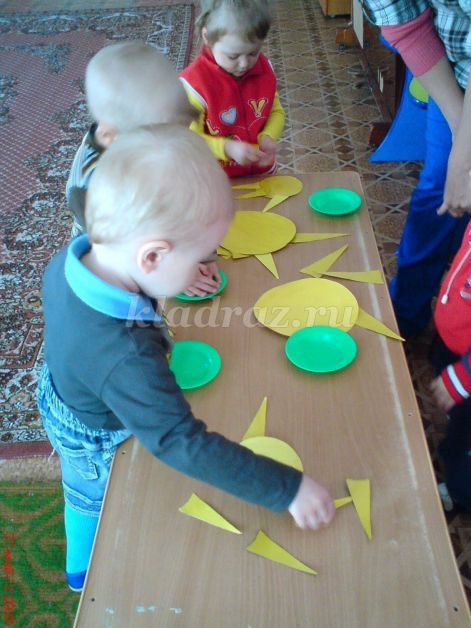
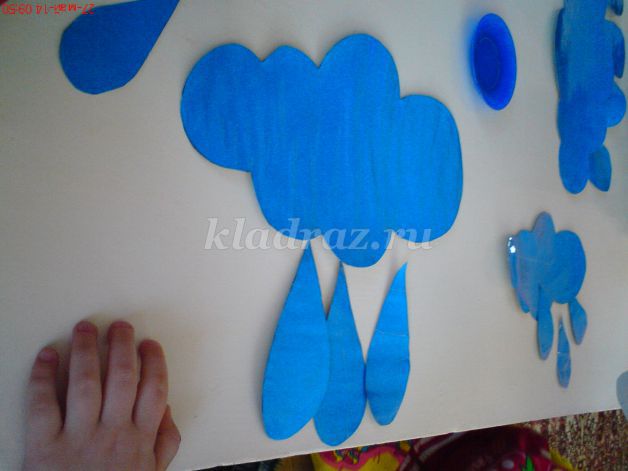
Guys, the wind blew, clouds appeared in the sky and it began to rain. Here we have clouds: big and small. Large droplets drip from a large cloud, small droplets from a small one. Place the droplets near the clouds. I’m checking the size and color of the clouds. I cover the sun with a cloud. Educator. Guys, now let's talk about the sun and the rain. Screening of the presentation “Sunshine and Rain”.
Presentation “Sun and Rain”
Finger painting on semolina “The rain was dripping.” When drops fall from a cloud to the ground, they leave traces. Let's draw the trails of the droplets. Place your finger, press and remove. Here one drop fell. And a lot of droplets fall from the cloud, so we’ll do this with our finger many times. You will get a lot of drop marks. How many drops fell from the cloud? Lots of drops. I'm removing the cloud. The sun is peeking out. P/I “The sun is rising.” This is how the sun rises. Higher, higher, higher. (Raise your hands up, stretch) By night the sun will set Lower, lower, lower. (Sit down slowly, lower your hands to the floor) Okay, okay. The sun laughs. And we all have fun under the sun. (Clap your hands) Well done!
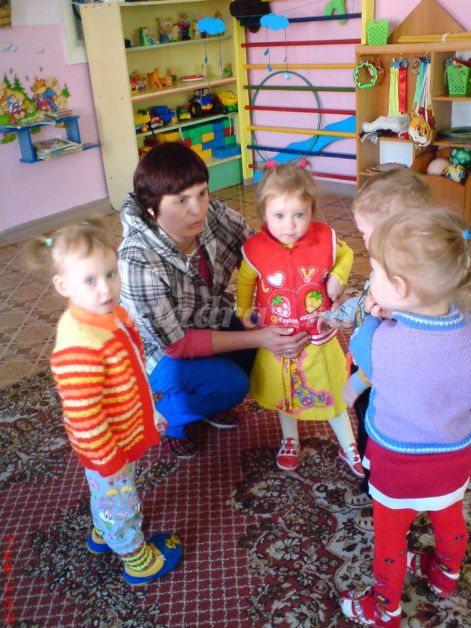
We recommend watching:
Scenario of sports leisure for children of the 2nd junior group “Winter fun for kids” Synopsis of a game lesson in an early age group Synopsis of a lesson on sensory education of the 1st junior group Synopsis of educational activities with presentation for the 1st junior group
Similar articles:
Folklore entertainment for children of primary preschool age in kindergarten. Scenario
Gaming leisure time in 1st junior group
Lesson summary for an early age group. Vegetables: turnips and carrots
Lesson summary for an early age group. Vegetables: beets and potatoes
Summary of a lesson in an early age group on a winter theme. Hare and fox
